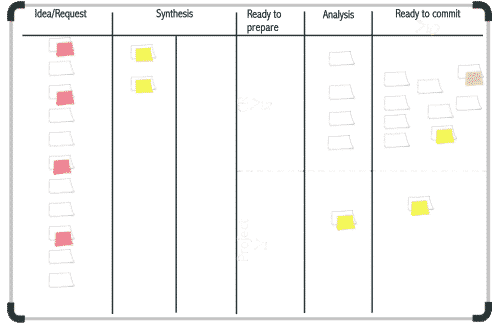What do you think when you hear the word Lean?
Most people would think fit, skinny, or maybe even shredded, but not Alexander Novkov. He and his colleagues at Kanbanize are fascinated with the idea of being Lean at Work. Everyone there specializes in cutting off wasted time and useless meetings and building that ripped work-day.
So, if you want to get some of that, here’s Alex. He’ll be your guide to an awesome approach to getting more done.

What does it mean to be lean? In life, the first thing that comes to mind is to have a fit body and feel comfortable in your skin. However, lean has a whole other meaning, which is not that popular outside of the software development and manufacturing communities.
To be lean actually means to seek more value from everything you do and constantly find ways to get rid of everything that gets in the way of that. This is a fulfilling way of living, especially when it comes to being more productive.
Caught your interest? If you stick around until the end of this article, you’ll learn what the Lean methodology is. You’ll get an idea where it comes from, how to become lean at your work and therefore be more productive than you ever thought was possible.
What is Lean?
Lean is a management methodology built on 3 simple ideas:
- Deliver value from your customer’s perspective
- Eliminate waste (things that don’t bring value)
- Chase continuous improvement
It was developed by Toyota shortly after the end of WWII and it transformed the company from a small carmaker to the largest automobile manufacturer in the world.

Lean gained massive popularity in the manufacturing world and later became a primary management philosophy in software development. Currently, it is taking over the marketing world and is steadily spreading to other industries.
The great thing about Lean is that it can be applied both on a large and small scale. This means that even if your boss has no clue what Lean is, you can implement it and reap the benefits of the methodology on an individual level.
You just have to embrace a point of view where you are the manager of your time and actions and therefore run your career as a project.
The 5 Steps to Becoming Lean
The great thing about Lean is that the methodology is quite simple and leads to significant improvements in a short period of time.
You just need to follow a set of 5 principles that can be considered as the constitution of Lean (not an official term):
- Identify value
- Map value stream
- Manage flow
- Establish pull
- Seek perfection
Each principle is equally important and if you truly want to become more productive and get the most of Lean, I advise you to stick with all of them.
Identify value
By definition, value is everything your customer is paying you for.
When working, you are trading your time and skills for a negotiated financial compensation. Therefore, your direct customer is your employer. The more value you bring to your client the higher compensation you would be entitled to.

In order to be more productive and precious to your employer, you need to have a clear idea of the value of your actions. Let’s face it, we’ve got 2-3-5 primary responsibilities and tens of secondary duties in our work life, which require our time, attention and drain our energy.
When applying the first principle of Lean, consider the value and waste (activities that don’t bring direct value) in your work. Identify those that bring the greatest benefit to you and your employer and find a way to spend more time on them.
For example, the real value of a software developer’s work is the code they write, for a copywriter, it is the content she creates and so on.
Map value stream
The goal of this principle is to visualize your work so you can have a clear idea of how many tasks you have on your hands, how you are progressing, and where work gets stuck.
In Lean, the typical tool for that purpose is the Kanban method. Explained shortly, it is a system of boards (Kanban boards) divided vertically by columns representing the stages of your work process (Requested, In Progress, Done). Every task that you need to complete is hosted on a Kanban card that contains information about the assignment.

As you make progress, you move your card/s to the corresponding stages of your workflow. Quite simple, really.
The great thing about Kanban is that similarly to Lean itself, it can be applied on an organizational, team, and individual level. With the comfort that the digital age provides us, you can have a digital Kanban board at your disposal all the time with just a few clicks on your phone and never lose track of how your affairs are progressing.
Although this is by far the most popular method for value stream mapping, you are not limited to using it. You just need to find a way to make it transparent how your work is progressing in order to reach your maximum levels of productivity.
Manage flow

The third principle of Lean aims to help you achieve great efficiency by keeping your process running all the time.
You need to consider your role in your organization and how you collaborate with your colleagues:
- What is your biggest bottleneck?
- How can you alleviate it?
- How do your actions affect the rest of the team?
- Are you a bottleneck to somebody?
Understanding how your work is flowing through the different stages of the process will help you optimize your performance and become more productive.
In addition, by investing effort in minimizing the negative effect of the bottlenecks in your process, you will be able to generate value not only for your employer but for your colleagues as well.
Establish pull
The concept of pull is among the foundations of Lean’s success and a key element in maintaining a flow of work.
To implement it, you need to change the way you start new work. Your goal is to do it, only when there is a demand and you’ve got the capacity to focus on it.

This way, you will be able to deliver value precisely when it is needed and avoid getting overburdened. As a result, you will be able to increase the quality of your work and the speed of delivery bringing more value to your customer.
Surprising or not, the most typical reason for being unproductive is the habit of multitasking. Contrary to popular belief, multitasking harms your productivity. It is nothing but a constant context switching that prevents you from focusing on a task long enough to create a flow of thought.
It keeps you busy all the time without making significant progress on the tasks that you are juggling. As a result, you can easily feel overwhelmed, drained, and stressed out without getting anything positive from it.
The solution: work on as few items as possible and avoid switching context unless it’s absolutely necessary.
The fourth principle of Lean builds on the foundation that you should have laid by implementing the first three steps. It complements them and scales the effect of each one.
Seek perfection
Don’t we all seek perfection in some way? The great thing about becoming lean is that you have the means to chase it. The last of the five principles encourages you to seek continuous improvement of everything you do.

You can start by getting rid of as many waste activities as possible from your day. They will only distract you and prevent you from delivering more value to your customer. Lean categorizes 2 types of waste:
- Necessary
- Pure
The necessary waste activities are those that don’t bring direct value to your customer but support the activities that do. For example, the code reviews in software development are a necessary waste because they ensure that the quality of your product meets the company standards.
On the other hand, preparing estimation reports about the release date of a feature is a pure waste because you can never estimate with absolute precision. Not to mention that you’d be tempted to give yourself more time than you actually need just to be sure that the prognosis is accurate.
Logically, you need to do everything in your power to minimize waste. If you don’t have the authority to act independently, having a productive conversation on the topic with your supervisor is the best thing you can do for your company. 🙂
When you’ve minimized the waste, you need to increase the value of your actions. A simple model for implementing continuous improvement in practice is the Plan-Do-Check-Act (PDCA) model.
You can apply it to everything you do and therefore aim to improve further every time. You should be constantly looking for ways to improve your performance and bring more value to your customer.
Adopting the principles of Lean by heart may take some time but once they’ve become part of your mindset, you’ll be able to focus on the important things in your work and life in general like never before.
If you’ve been struggling to achieve the levels of productivity you think you are capable of, Lean might be just the thing you’ve been looking for.


